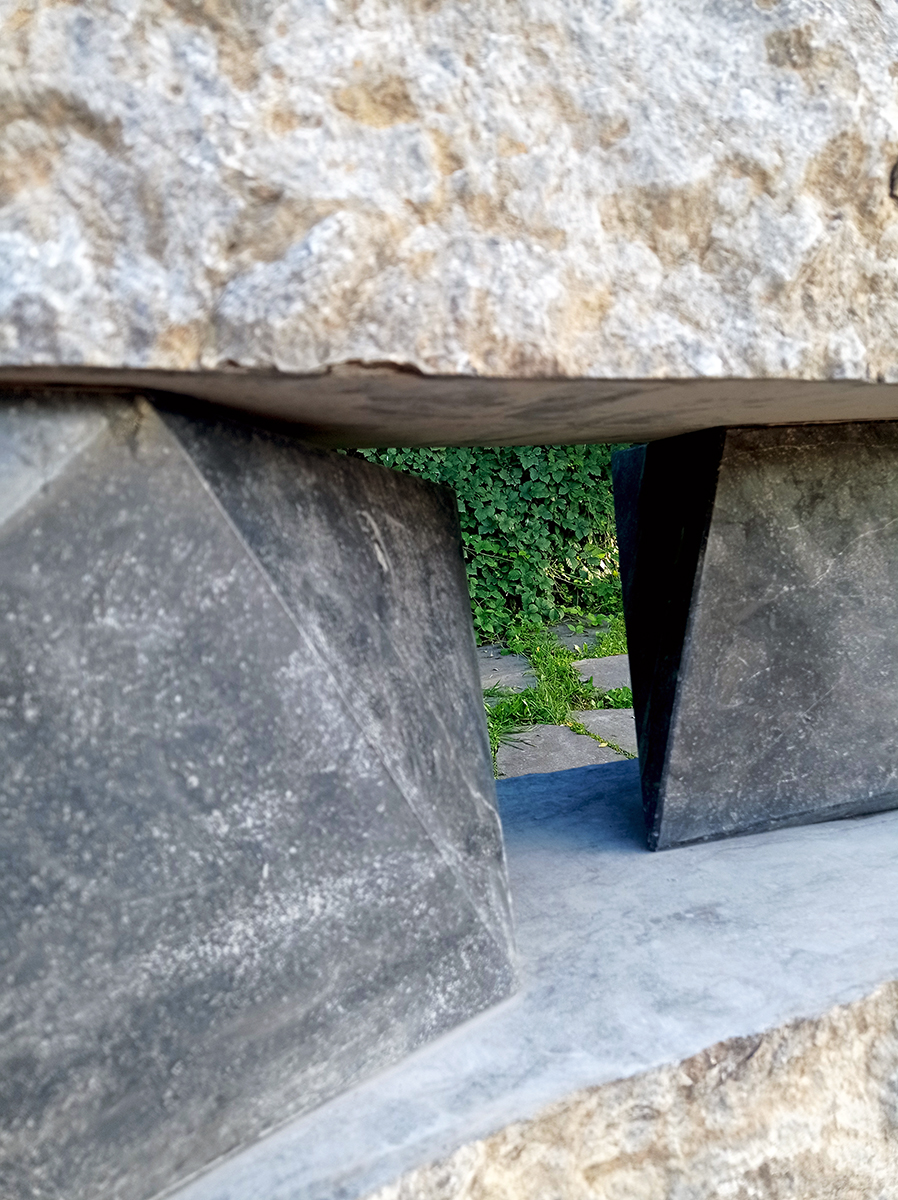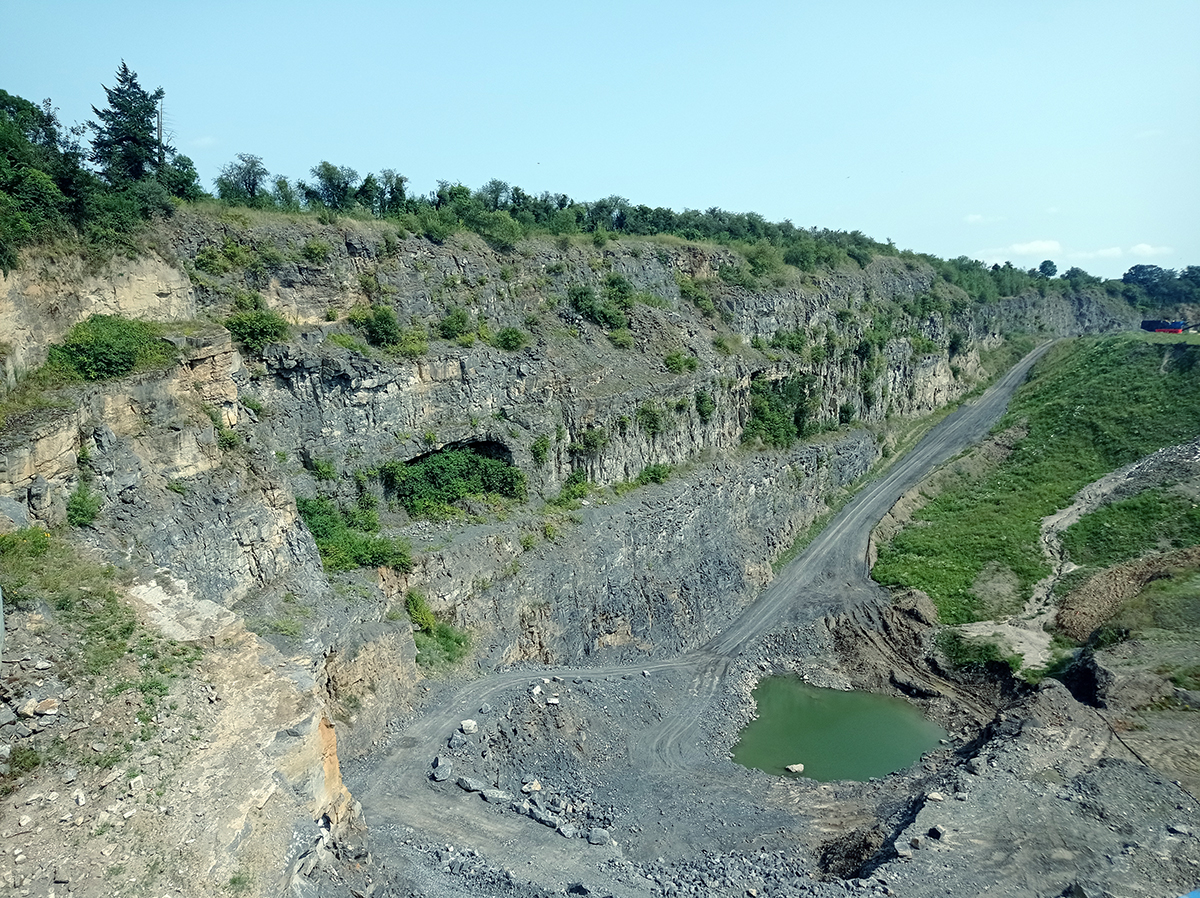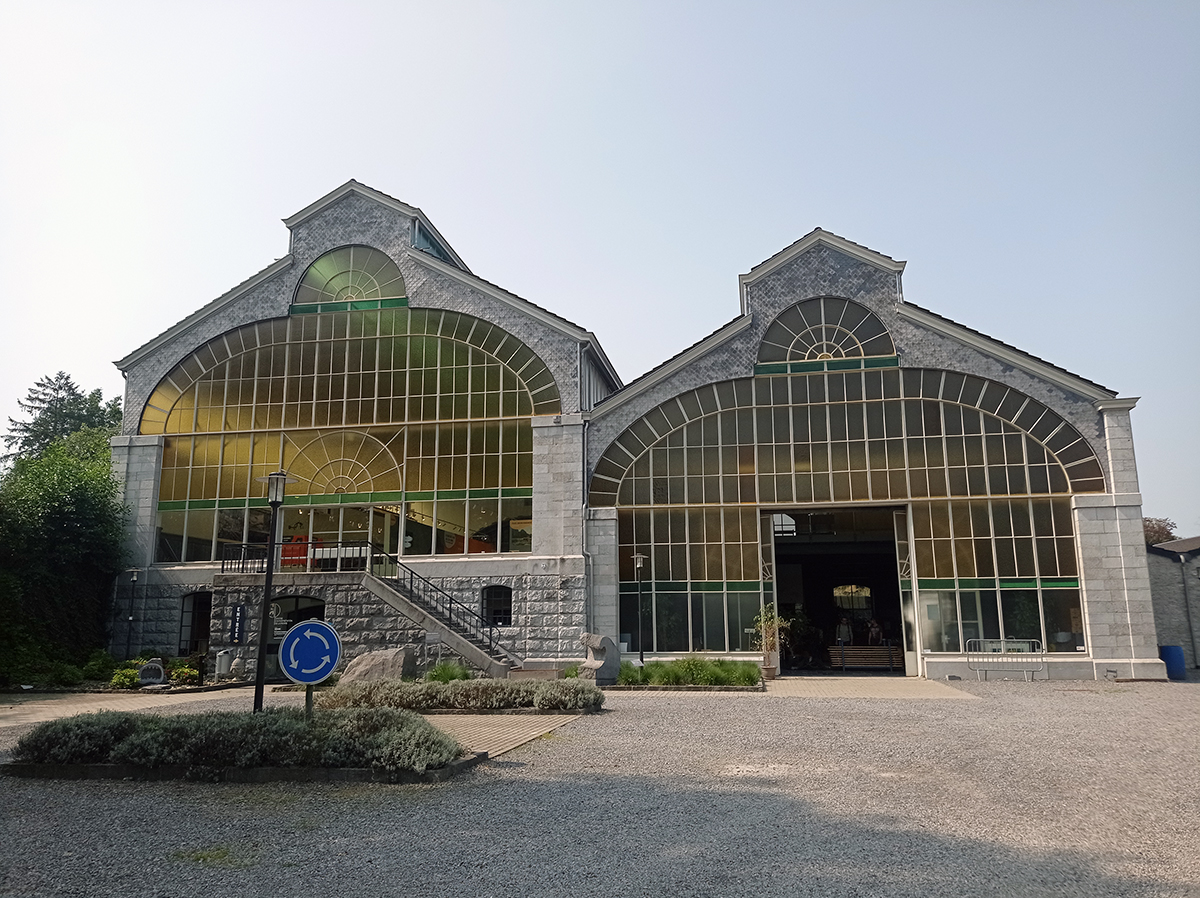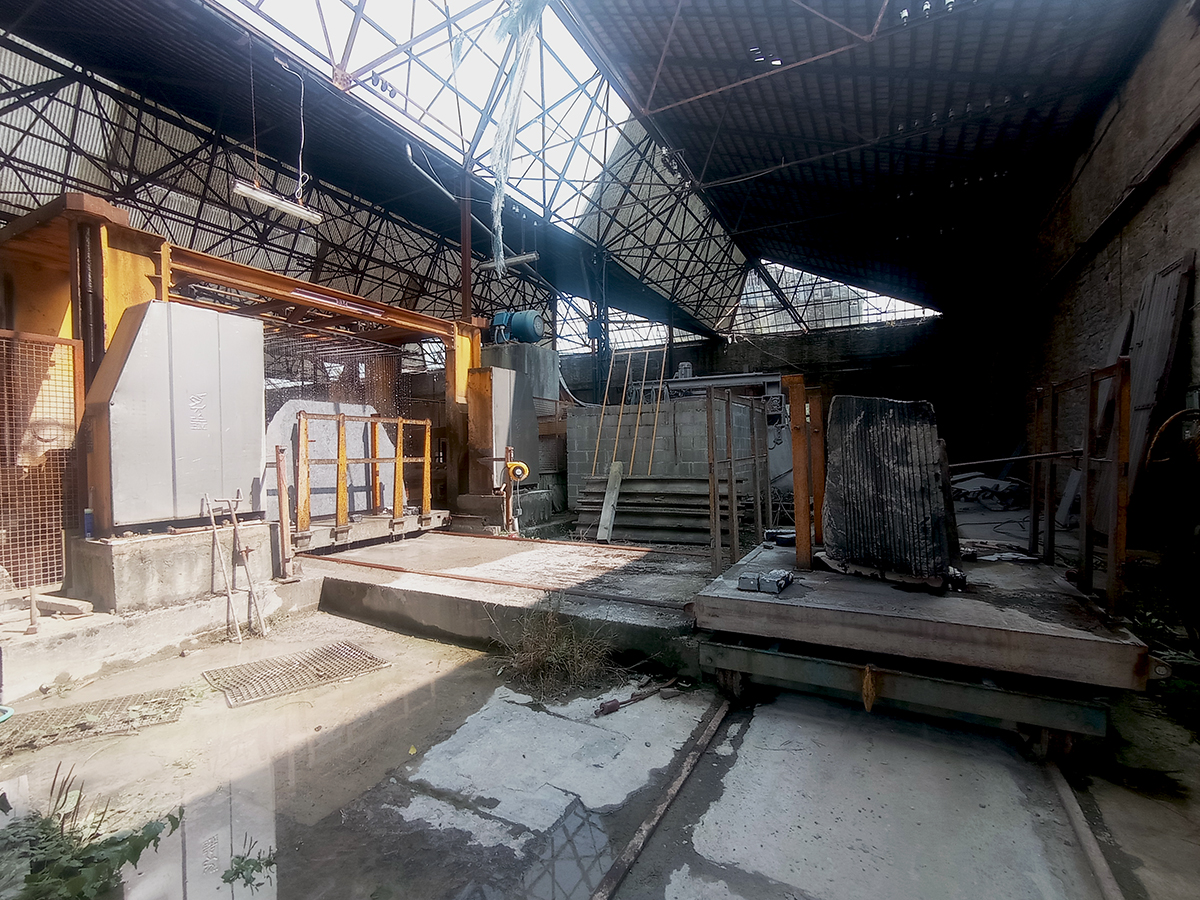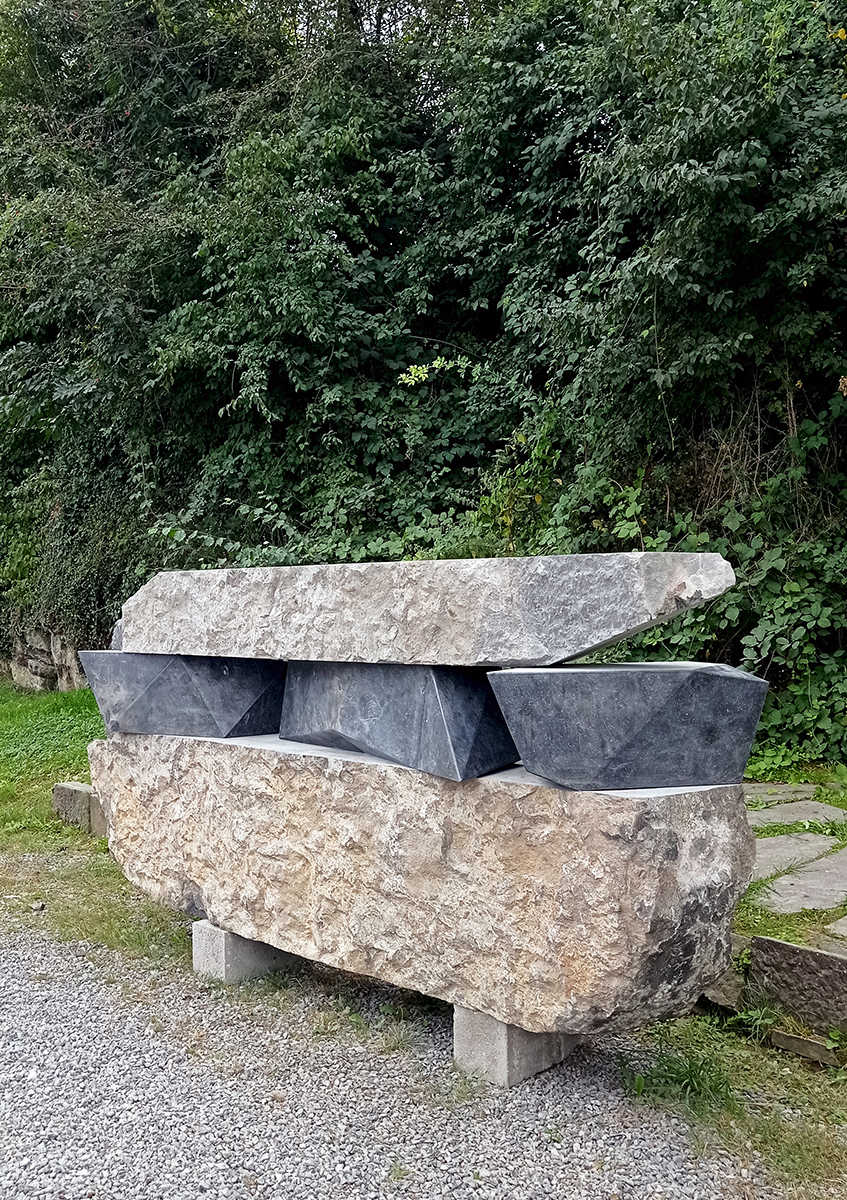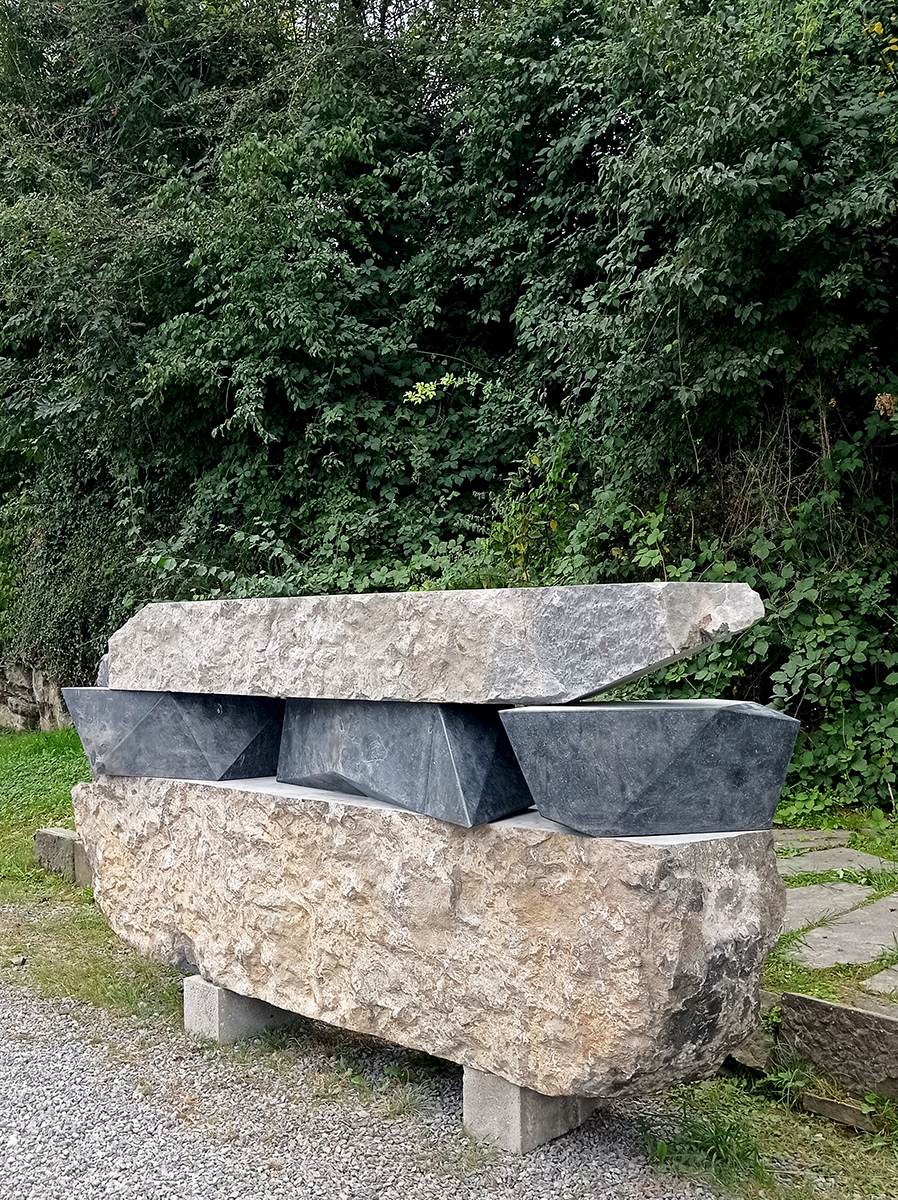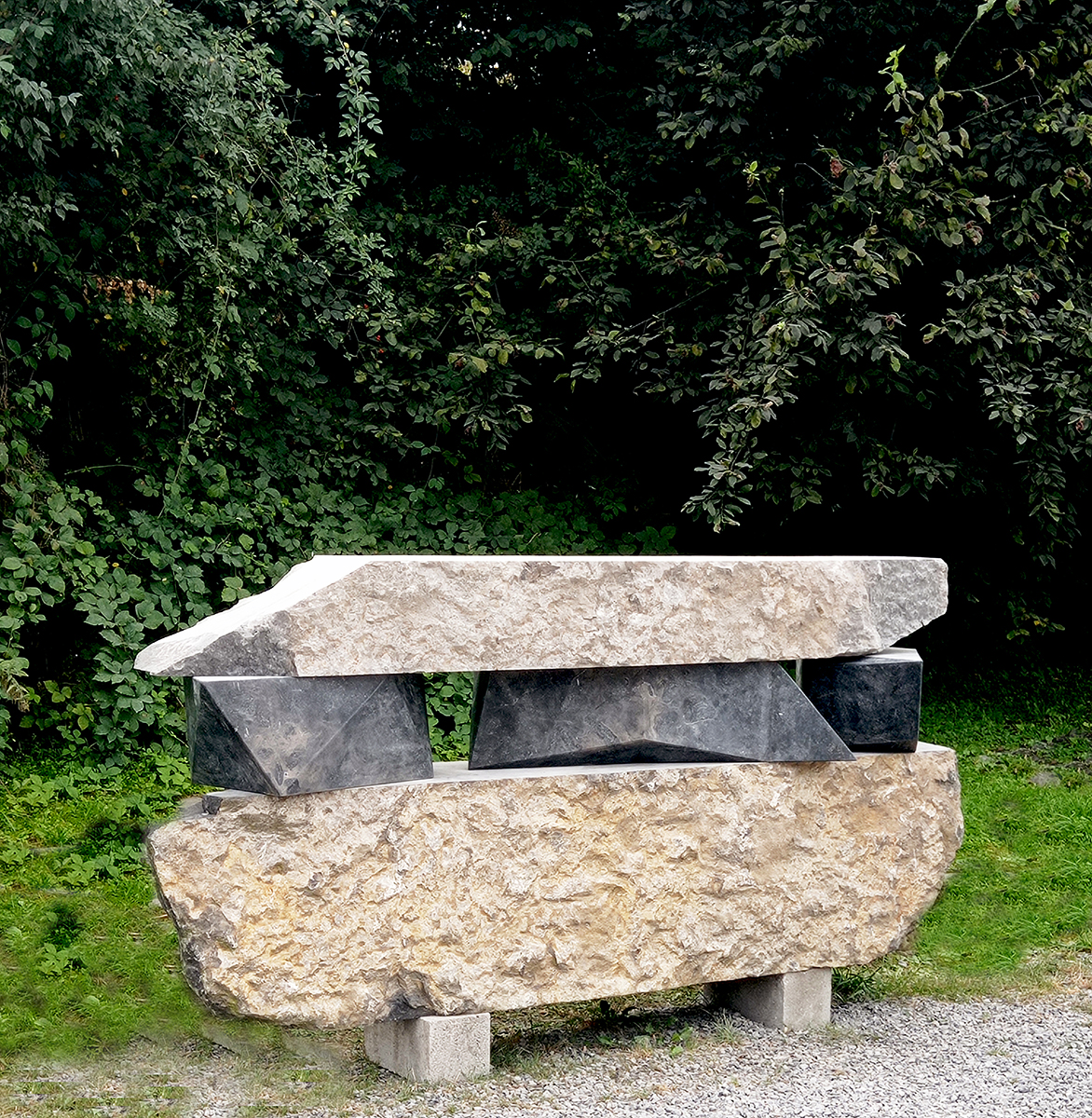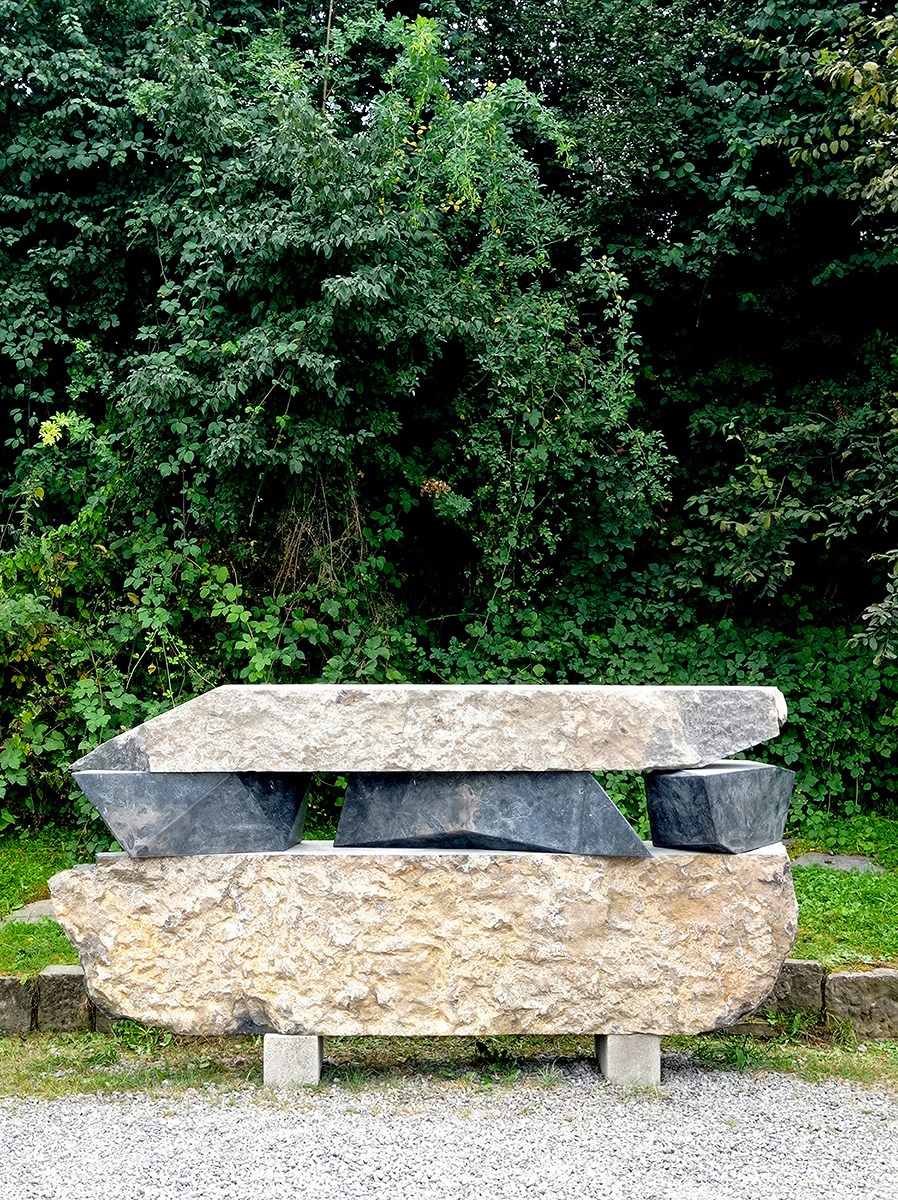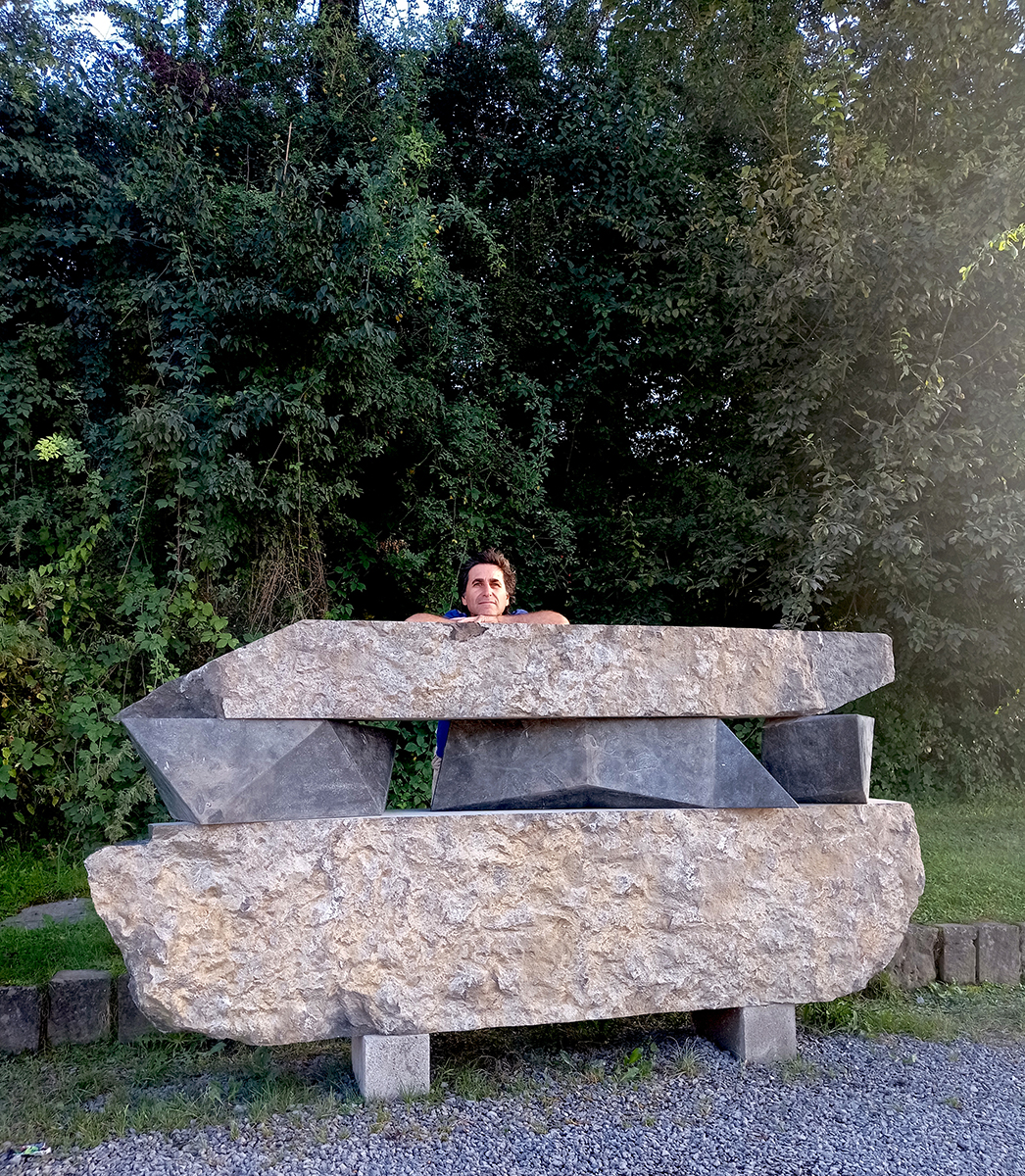The sculpture “Libertação” is the result of an artistic residency in Sprimont, Belgium, which took place from September 22 to August 8 at the Stone Interpretation Center. This creation is part of the celebrations of the 30th anniversary of the International Sculpture Symposium of Sprimont, which brought together twelve sculptors from various nationalities. The work was sculpted in “Bleu” stone extracted from the local quarry, which serves as the foundation for the creation of “Libertação.”
(PT)
A escultura “Libertação” é o resultado de uma residência artística em Sprimont, Bélgica, que decorreu de 22 de setembro a 8 de agosto, no Centro de Interpretação da Pedra. Esta criação insere-se nas comemorações do 30.º aniversário do Simpósio Internacional de Escultura de Sprimont, que reuniu doze escultores de várias nacionalidades. A obra foi esculpida em pedra “Bleu” extraída da pedreira local, que serve de base à criação de “Libertação”.
A partir de uma laje de “Petit Granit belga” com cerca de 350 milhões de anos, desenvolvi uma escultura que explora a liberdade como um conceito intemporal, gravado na própria matéria da rocha. A obra também reflete a amizade duradoura entre Portugal e Bélgica, representando o legado humano, reforçado pela significativa presença de portugueses na cultura e economia belgas desde os anos 60.
A escultura tem dimensões de 270 x 120 x 70 cm e é composta por um bloco bruto dividido em três partes horizontais: uma base de 60 cm e duas camadas superiores de 30 cm. A porção central foi trabalhada em formas geométricas polidas.
A formação lenta da rocha, sob intensas pressões ao longo de milhões de anos, convida-nos a refletir sobre o tempo e a paciência necessários para atingir a plena liberdade. As três formas geométricas polidas representam o legado que as comunidades deixam às gerações futuras, fruto de um processo coletivo de construção de liberdade e fraternidade.
O destino da escultura está ainda a ser discutido com várias instituições portuguesas em Bruxelas, onde se pretende que a obra seja exposta.
A minha participação nesta residência artística foi profundamente enriquecedora, a nível artístico, humano, cultural e social. Gostaria de destacar três experiências que me marcaram:
1.º – O Centro de Interpretação da Pedra em Sprimont possui uma coleção impressionante, abrangendo áreas como geologia, arqueologia, extração de pedra e escultura. Considero que, dada a importância histórica da nossa região, seria pertinente criarmos uma infraestrutura semelhante na região Centro de Portugal.
2.º – Acompanhei um programa de reabilitação de jovens envolvidos em crimes graves, no qual participaram na criação de uma escultura de grande escala, destinada à cidade de Liège. A evolução dos trabalhos demonstrou o impacto positivo desta experiência nos jovens. Acredito firmemente no poder transformador da arte e na sua capacidade de marcar vidas de forma decisiva, o que reforça a importância de uma abordagem mais profunda e abrangente às atividades artísticas.
3.º – A comunidade portuguesa está presente em diversas partes da Bélgica, e Sprimont não é exceção. Tive o prazer de conhecer vários portugueses, residentes na Bélgica há muitos anos, que são respeitados e integrados nas atividades culturais e económicas locais. Este forte vínculo com Portugal, aliado a uma perspetiva enriquecida por novas experiências, representa um enorme potencial que devemos valorizar e saber escutar.
(FR)
La sculpture “Libertação” est le résultat d’une résidence artistique à Sprimont, en Belgique, qui s’est déroulée du 22 septembre au 8 août, au Centre d’Interprétation de la Pierre. Cette création s’inscrit dans les célébrations du 30e anniversaire du Symposium International de Sculpture de Sprimont, qui a réuni douze sculpteurs de différentes nationalités. L’œuvre a été sculptée dans la pierre “Bleu”, extraite de la carrière locale, servant de base à la création de “Libertação”.
À partir d’une dalle de “Petit Granit belge” datant d’environ 350 millions d’années, j’ai développé une sculpture qui explore la liberté en tant que concept intemporel, gravé dans la matière même de la roche. L’œuvre reflète également l’amitié durable entre le Portugal et la Belgique, représentant l’héritage humain renforcé par la présence significative de Portugais dans la culture et l’économie belges depuis les années 60.
La sculpture mesure 270 x 120 x 70 cm et est composée d’un bloc brut divisé en trois parties horizontales : une base de 60 cm et deux couches supérieures de 30 cm. La partie centrale a été travaillée en formes géométriques polies.
La lente formation de la roche, sous des pressions intenses pendant des millions d’années, nous invite à réfléchir sur le temps et la patience nécessaires pour atteindre la liberté pleine et entière. Les trois formes géométriques polies représentent l’héritage que les communautés transmettent aux générations futures, fruit d’un processus collectif de construction de liberté et de fraternité.
Le destin de la sculpture est encore en discussion avec plusieurs institutions portugaises basées à Bruxelles, où l’on souhaite exposer l’œuvre.
Ma participation à cette résidence artistique a été profondément enrichissante, tant sur le plan artistique qu’humain, culturel et social. J’aimerais souligner trois expériences qui m’ont particulièrement marqué :
- – Le Centre d’Interprétation de la Pierre à Sprimont possède une collection impressionnante couvrant des domaines tels que la géologie, l’archéologie, l’extraction de la pierre et la sculpture. Compte tenu de l’importance historique de notre région, il serait pertinent de créer une infrastructure similaire dans la région Centre du Portugal.
- – J’ai suivi un programme de réhabilitation pour jeunes impliqués dans des crimes graves, où ils ont participé à la création d’une sculpture de grande envergure, destinée à la ville de Liège. L’évolution des travaux a démontré l’impact positif de cette expérience sur les jeunes. Je crois fermement au pouvoir transformateur de l’art et à sa capacité à marquer les vies de manière décisive, ce qui renforce l’importance d’une approche plus approfondie et globale des activités artistiques.
- – La communauté portugaise est présente dans plusieurs régions de Belgique, et Sprimont n’y fait pas exception. J’ai eu le plaisir de rencontrer plusieurs Portugais vivant en Belgique depuis de nombreuses années, respectés et intégrés dans les activités culturelles et économiques locales. Ce lien fort avec le Portugal, allié à une perspective enrichie par de nouvelles expériences, représente un potentiel énorme que nous devons valoriser et savoir écouter.
(EN)
The sculpture “Libertação” is the result of an artistic residency in Sprimont, Belgium, which took place from September 22 to August 8 at the Stone Interpretation Center. This creation is part of the celebrations of the 30th anniversary of the International Sculpture Symposium of Sprimont, which brought together twelve sculptors from various nationalities. The work was sculpted in “Bleu” stone extracted from the local quarry, which serves as the foundation for the creation of “Libertação.”
Using a slab of “Belgian Petit Granite” approximately 350 million years old, I developed a sculpture that explores freedom as a timeless concept, engraved into the very material of the rock. The work also reflects the enduring friendship between Portugal and Belgium, representing the human legacy, reinforced by the significant presence of Portuguese people in Belgian culture and economy since the 1960s.
The sculpture measures 270 x 120 x 70 cm and is composed of a raw block divided into three horizontal sections: a 60 cm base and two upper layers of 30 cm. The central portion has been worked into polished geometric shapes.
The slow formation of the rock, under immense pressure over millions of years, invites us to reflect on the time and patience needed to achieve full freedom. The three polished geometric shapes represent the legacy that communities pass on to future generations, the result of a collective process of building freedom and fraternity.
The final placement of the sculpture is still under discussion with several Portuguese institutions in Brussels, where the work is intended to be exhibited.
My participation in this artistic residency was profoundly enriching on artistic, human, cultural, and social levels. I would like to highlight three experiences that deeply impacted me:
- – The Stone Interpretation Center in Sprimont has an impressive collection, covering areas such as geology, archaeology, stone extraction, and sculpture. Considering the historical significance of our region, I believe it would be worthwhile to create a similar infrastructure in the Central region of Portugal.
- – I followed a rehabilitation program for young people involved in serious crimes, in which they participated in creating a large-scale sculpture for the city of Liège. The progression of the work demonstrated the positive impact this experience had on the young participants. I firmly believe in the transformative power of art and its ability to leave a lasting mark on lives, reinforcing the importance of a deeper, more comprehensive approach to artistic activities.
- – The Portuguese community is present throughout Belgium, and Sprimont is no exception. I had the pleasure of meeting several Portuguese people who have been living in Belgium for many years, respected and integrated into local cultural and economic activities. This strong bond with Portugal, combined with a perspective enriched by new experiences, represents an enormous potential that we must value and learn to listen to.
CLIPPING
https://www.cip-sprimont.be/agenda/festival-de-sculpture-sur-pierre-de-sprimont-2024/
Thierry Ferreira criou uma escultura que simboliza a união entre Portugal e a Bélgica
